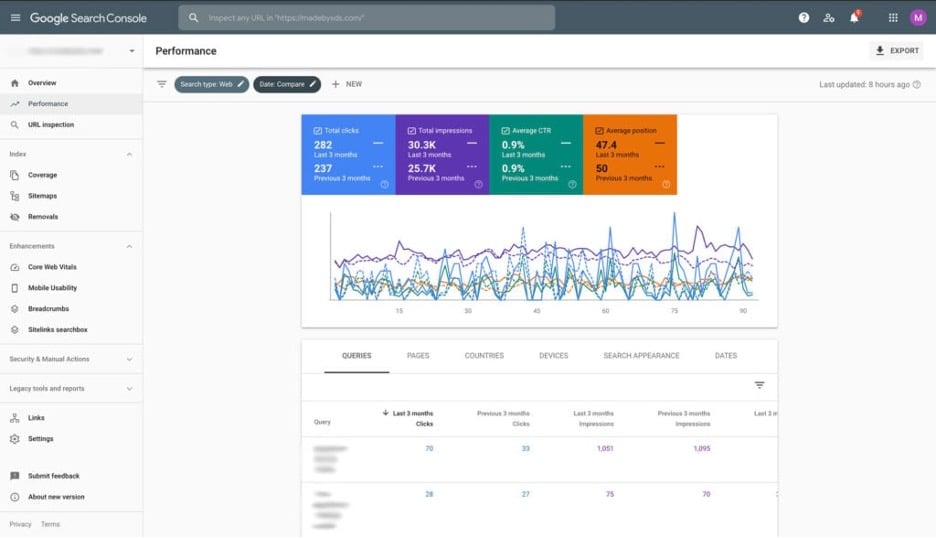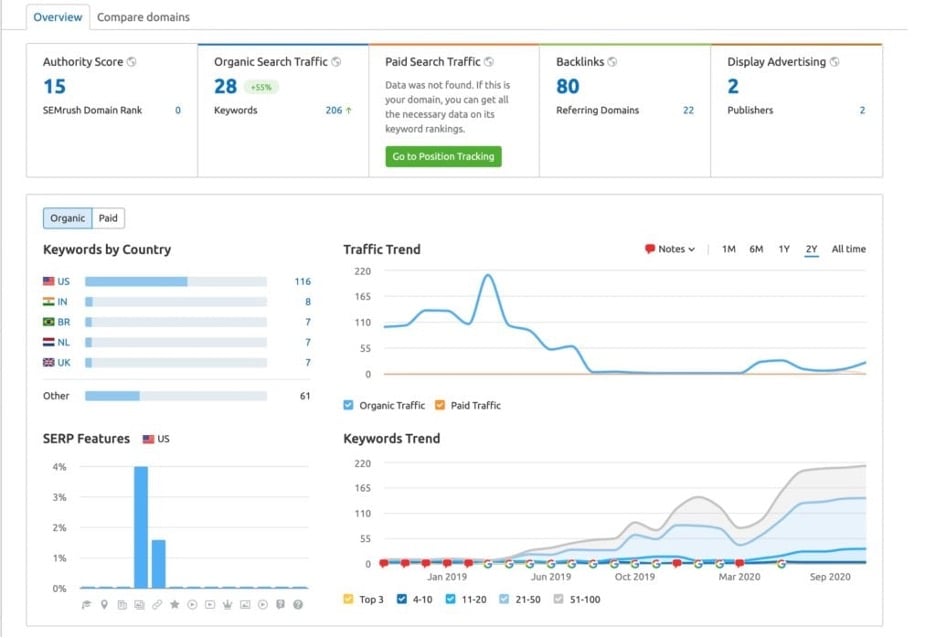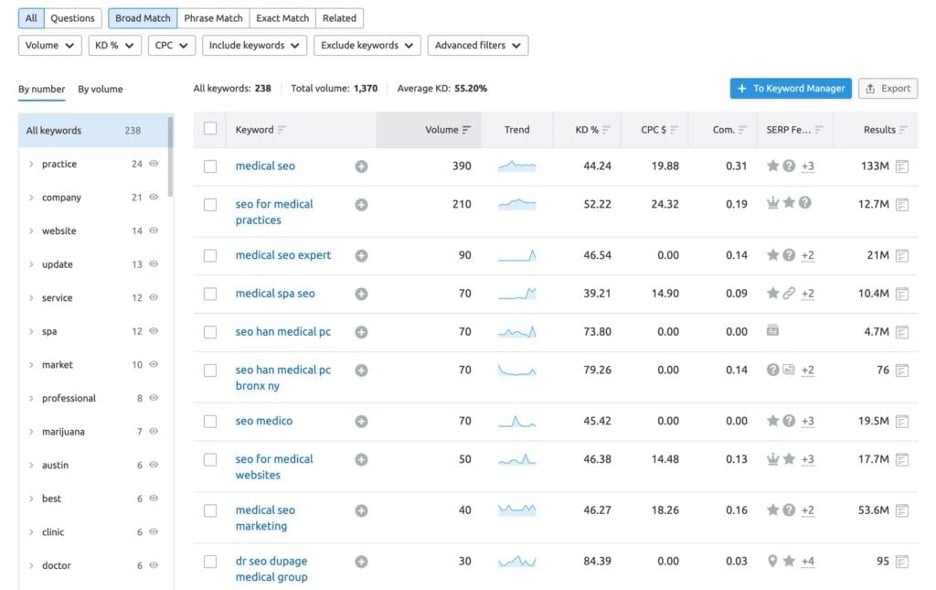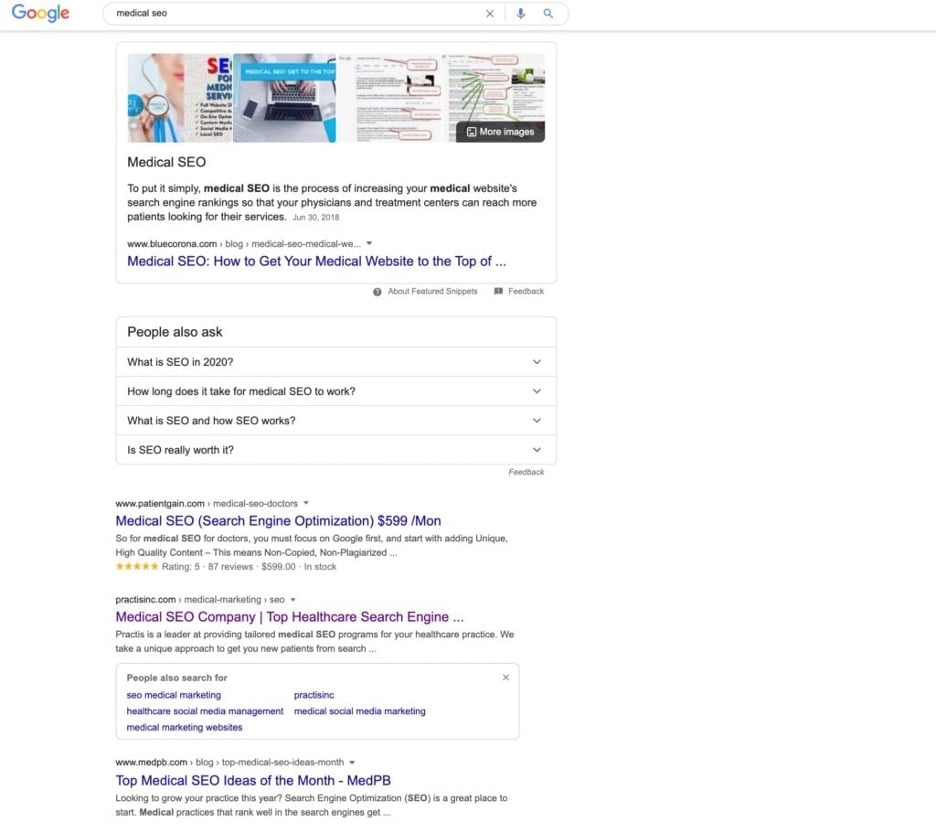Medical SEO has become a necessity that should be part of every well-developed medical marketing strategy. The healthcare industry is ever-changing and at an incredibly accelerated pace in 2021.
Last Updated: 07/28/24
TABLE OF CONTENTS
SEO FOR MEDICAL WEBSITES
Today, when customers start their journey for healthcare services, prescriptions, therapies, or other medical needs, the first step is normally taken on their laptop or mobile device.
According to reports from Datareportal, “81% of people search online for a product or service“. SEO is about meeting your audience where they are. If they can not find your website online, they will find your competitors.
Patients and healthcare professionals input specific medical queries (keywords) into search engines such as Google, Yahoo, or Bing. The Search Engine Results Page (SERP) then displays a curated selection of website links, complete with customized title tags and meta descriptions. These elements help users identify the most relevant and authoritative sources for healthcare information, guiding their selection process.
THINK LIKE YOUR TARGET AUDIENCE
When trying to understand what a potential customer will do online, it’s a good rule of thumb to simply think back to what you would do as a prospective customer.
- When you enter something into Google or Bing, how many pages do you scroll through to get an answer to your query?
- Where on the screen do you tend to click most frequently?
- What entices you to click on websites?
In answering these questions, we can begin to understand why medical SEO is critical.
Most people don’t tend to click past the first page, so that’s where your website needs to be when your customers type in a query related to your business or products.
SEO for medical websites or centers of care can be more challenging than other fields, as there are additional regulations, policies, and important safety information to keep in mind. However, that doesn’t mean you can’t start ranking for the keywords you want. Because of the complexities, many medical companies turn to healthcare digital marketing agencies like XDS.
7 Steps To Improve Keyword Rankings
1) PERFORM A MEDICAL SEO NEEDS ASSESSMENT
When beginning to plan your SEO strategy, the first thing you need to do is figure out what your goals and needs are:
- "Are you ranking #1 for all of your branded keywords?
- Are you focused on gaining some organic traffic for any specific pages on your website?
- Are you looking to get more conversions for newsletter or email subscriptions?
- Would you like to attract new potential patients or HCP/business customers?
- Are there any specific non-branded keywords you are looking to rank for?"
QUESTIONS TO ASK YOURSELF
If any of the above are goals you’d like to achieve, healthcare and medical SEO experts can begin to formulate a plan and move to more specific follow up questions. Think about the following before forging ahead:
- Who is, directly and indirectly, competing with you? What are their websites and/or company names?
- Who is your current target audience?
- Who else, ideally, do you want to be visiting and engaging with your website? Are there multiple groups?
- Are you running any healthcare PPC ads?
- Does you already have a social media strategy for healthcare?
- What is remarkable about your brand, product, or service?
- What is your company’s vision and mission? Specify the marketable features of your product/service.
- What are the search terms that are unique to your customer or patient experience?
Done answering these? Great!
You’re ready for the next step, and if you’re working with marketing experts, they are too!
2) SET UP GOOGLE ANALYTICS, GOOGLE SEARCH CONSOLE & GOOGLE TAG MANAGER FOR ANALYTICS
Leveraging Google Search Console, Google Analytics, and Google Tag Manager (GTM) forms a holistic strategy for enhancing keyword rankings on medical websites.
Google Search Console offers valuable data on search queries and indexing status, allowing for targeted keyword optimization.
Google Analytics provides in-depth insights into user behavior, facilitating content and user experience improvements.
Meanwhile, GTM simplifies the process of deploying and managing various tracking tags, enhancing analytical accuracy.
Together, these tools create a comprehensive framework for tracking performance metrics, enabling healthcare organizations to fine-tune their medical SEO strategies and secure higher placements on Search Engine Results Pages (SERPs).

Google Search Console Dashboard Showing a Performance Report
Other Helpful Platforms and Tools:
These are all great ways to set benchmarks and track your search engine optimization goals on a regular basis. If you are unable to do these in-house, turn to a medical digital marketing agency for help.
3) RUN An SEO WEBSITE AUDIT
A healthcare or medical SEO audit is a fantastic way to attain an inside look at how your website is performing.
Performing technical SEO audits is a comprehensive process that analyzes the technical health of a website, ensuring it's optimized for search engine crawlers.
A well-executed technical SEO audit can reveal issues that may be hindering a website from achieving its optimal search engine ranking. For instance, slow-loading pages can deter users, and search engines may consequently rank those pages lower.
Likewise, if a site has numerous broken links or its content isn't properly indexed, it could negatively impact keyword rankings.
By addressing these issues search engines can crawl and index the content more efficiently, which, in turn, improves keyword rankings.
SEMRush is a multi-faceted tool that allows SEO experts to check a number of things on your website domain. Their “Site Audit” tool helps identifies many of these technical SEO issues.

A domain overview on SEMRush will show, amongst other things, these 3 key insights and metrics:
- Authority Score- the overall quality of a website. This score tends to take in the following: domain authority, page authority, total backlinks, quality backlinks and more! To run an audit on your site for free, checkout Website SEO Checker.
- Organic Search Traffic- the amount of traffic you receive in a set time from people searching keywords that your page organically ranks for in SERPs. To check this for free, add the Google Analytics tracking code to your website. Need help? Have your developer do this for you. Once this is done, you can see real-time information on how users interact with your site. To see individual queries, make sure to connect Google Analytics to your Google Search Console.
- Backlinks- the links from other websites that lead to your own site. For example, if you were covered by a news outlet and they linked to your website in the article, that would be considered a backlink. To check this for free you can use Siteliner. Siteliner will also show you the total number of links on your webpage along with the median for all other sites, page load time and more so you can set appropriate goals.
After performing a domain overview, you can dive even deeper.
4) CONDUCT THOROUGH SEARCH ENGINE OPTIMIZATION KEYWORD RESEARCH
When redesigning a medical website, the strategic use of keyword research is critical for enhancing search rankings.
To follow best pharma SEO keyword research practices, choose one primary keyword that encapsulates the main focus, laying the foundation for targeted SEO efforts. Complement this primary keyword with a selection of secondary keywords that are semantically or thematically aligned. These can be incorporated into the content, meta tags, and URLs to further optimize each page's SEO profile.
Specialized SEO tools are invaluable in this endeavor, as they can identify 'low-hanging fruit' keywords—those ranking on the second or third search engine result pages—that have room for quick advancement. These tools also provide metrics on keyword difficulty and search volumes, enabling you to target terms that are less competitive but still have substantial traffic potential.
Another useful tactic is to examine the ""Searches related to"" section at the bottom of a SERP page, which can offer additional keyword ideas that are directly relevant to your primary keyword.
When choosing your medical SEO keywords, make sure to think about this in terms of specific search queries. In other words, what would someone actually be typing into a search bar to find you or your products online?
SEMRush has several great sections including the Keyword Gap tool and the Keyword Magic tool (listed above). Google Trends is another free resource that allows you to see upcoming or past keyword trends.

5) PINPOINT SEARCH INTENT
Search intent is a critical SEO factor.
Having superior search intent technology is vital for search engines to make money and attract users. When users can find exactly what they are looking for, with the least amount of effort and time, they’ll continue to use that search engine. In turn, Google, Bing and Yahoo reward sites with better positioning in SERPs if they do a good job with their search intent strategy.
Search intent is the “why” and the context behind the actual search phrase or query.
For example, the search query “eczema cream” could have multiple intents behind it:
- Someone is attempting to understand what eczema cream is and what it does
- There is a website called “eczema cream” that the person is trying to locate
- A buyer is in the market for eczema creams and wants to see which brand has the best product
- A buyer is in the market for eczema cream and wants to purchase a specific product
- Someone is trying to find a picture of eczema cream
TYPES OF Seach INTENT
Informational Intent is where users are seeking knowledge or answers to a particular question. This typically aligns with the awareness stage of the buyer's journey. At this point, the user is becoming aware of a problem or need and is seeking information to understand it better.
Examples:
- "What are the symptoms of the flu?"
- "How to lower blood pressure naturally?"
Best medical SEO practice to rank for informational keywords is to create educational content like blog posts, FAQs, or knowledge base articles. For a medical website, this could include articles on symptoms, causes, or general health tips.
Navigational Intent is where users want to visit a specific website or page. This often falls under the Consideration stage. Here, the user is already familiar with the brand or solution and wants to navigate directly to it.
Examples:
- "Mayo Clinic patient portal login."
- "American Medical Association membership page."
Best medical SEO practice to rank for navigational keywords is to ensure clear site architecture and utilize breadcrumbs. Make sure that specific pages like patient portals or service descriptions are easy to find with optimized meta tags and URLs.
Transactional Intent is where users are looking to make a purchase or perform a specific action. This corresponds to the decision stage of the journey. The user has decided to make a purchase or take a specific action, like scheduling an appointment.
Examples:
- "Buy blood pressure monitor online"
- "Schedule telehealth appointment"
Best medical SEO practice to rank for transactional keywords is to develop clear and compelling product/service pages, online booking systems, or e-commerce platforms. Include calls-to-action and ensure that the user experience is seamless.
Commercial Investigation Intent is where users are considering a purchase in the near future and are researching or comparing options. This overlaps with the Consideration stage. Users are actively comparing solutions or providers, trying to decide the best fit for their needs.
Examples:
- "Best orthopedic surgeons near me"
- "Comparison of health insurance plans"
Best medical SEO practice to rank for commercial investigation keywords is to create comparison charts, testimonial pages, or service benefit breakdowns. For medical sites, this could be a comparison of treatment options, patient success stories, or doctor qualifications.
Resource Intent is where users are looking for specific resources, often in the form of databases, portals, or research. This can span multiple stages, from Awareness to Post-Purchase. Users might be looking for deeper research, support forums, or databases, either to understand an issue better or to engage further with a chosen solution.
Examples:
- "Clinical trial databases for cancer treatments"
- "Medical research papers on Alzheimer's disease"
Best medical SEO practice to rank for resource keywords is to develop dedicated resource sections, research libraries, or community forums. For medical practitioners, this might include publishing white papers, hosting patient communities, or curating databases of relevant studies.
Additionally, you have to take into account more than just the keyword you want to show up. You need to look at context and user history patterns. SERPs for the keyword you want to rank for is a great place to start to glean some of this information. Start to see what articles appear for a keyword like “medical SEO”.

We can see here that the top ranking websites’ intent are 1) how to improve medical SEO and 2) companies that can help you achieve better SEO. If you were writing a blog to rank for “medical SEO,” you would want it to match one or both of these intents. It’s important not to write content for a keyword that does not match the current top SERPs’ intent; if you do this, you may never even make it onto the first page, even if you follow all the other rules of SEO.
6) IMPLEMENT ON-PAGE SEO
What makes up on-page SEO? There are many integral parts that make up successful on-page optimizations, but one of the most important part is the SEO linking strategy. With that in mind, there are different types of SEO links to pay attention to
- Internal Links- make sure the pages of your own website link to each other in a way that improves the user’s experience and makes it easy to find relevant information. When you have a link to your blog on your home page, this is an example of an internal link. Using a page's primary keyword as anchor text in internal links can reinforce keyword relevancy and help improve its rankings on search engines.
- Outbound/External Links- links that take the user to other websites. These links should be synonymous or relevant to the information you have on your own website. Google likes it when there are external links because it helps search engines get a better idea of what your site is about. When Google understands the intention of a site better, they feel more comfortable sending other users there. But be careful! If you link to sites with bad domain authority (DA) scores, it could hurt the DA of your own site, so make sure to always check the DA score before creating an external link.
Optimizing the user experience for your website ensures that websites not only cater to search engine algorithms but also provide a seamless and intuitive experience for users. UX design in healthcare not only improves patient engagement and satisfaction but also signals to search engines that the website is of high quality, thereby boosting its rankings and visibility in search results.
In order to improve your SEO, make sure you are meeting all linking benchmarks. You can find these benchmarks by using SEMRush or Siteliner. Other on-page SEO includes meta descriptions, page titles, section headers, alt tags, rich snippets, and content. Make sure you are including all these components when doing SEO for medical websites.
Google scans websites with an ever changing algorithm. The first step is finding out what pages exist on the web. You can directly tell Google not only what pages are on your website, but specifically which ones you want to be crawled using an XML sitemap.
Once Google is crawling your site, it takes a close look at the following, so make sure you’re using your selected keywords in these critical SEO locations:
- URL
- Page titles
- Meta descriptions
- Section headers
- Alt tags
- Rich snippets
- On-page content
Don’t “keyword stuff” in these sections, meaning only add your keywords when it makes logical sense, follows grammatical rules, and helps explain to Google (and other search engines) what is on each webpage. Every page on your site should have all of these seven key areas filled out.
Make sure to consider section headers (like h1s, h2s & h3s) when creating a website design and keyword placement when drafting your on-page content. It’s best to have your main keyword appear in the first sentence of your content. It’s also a good rule of thumb to match your meta description with the first paragraph of content on each page.
With the rise of AI search bots like ChatGPT and Google Gemini, people are increasingly turning to these platforms to find information, making it essential for healthcare providers to adapt their digital marketing strategies to stay visible in these evolving search environments.
The most effective strategy for enhancing AI visibility is to focus on creating high-quality content that ranks well in search engines. This is crucial because AI-driven platforms often pull information from websites that appear in the top 3 search results, making strong organic rankings essential for gaining exposure through these AI channels.
7) Create aN OFF-PAGE SEO Strategy FOR Your MEDICAL WEBSITE
To improve your search rankings, there are more than on-page SEO requirements to take into consideration.
Backlink/Inbound links are also important. When another website links to your website, this is an example of a backlink. High domain authority backlinks can be great for helping you move up in SERPs. If your SEO audit shows a toxic backlink from a spammy website, you can go to Google Search Console to submit a list of “Disavow” backlinks.
Backlinks are considered off-page SEO because it’s an improvement for which you have to do work “off the website.”
Some common ways to gain backlinks for medical websites are:
- Press releases
- Directory listings
- Brand mentions
- Social media
- Guest blogging
Lastly, as part of any off-page search engine optimization effort, every medical and healthcare brand needs to consider reputation management. This means looking at more than adverse medical events in online reviews and digging into the SEO benefits – use these reviews to find clues as to how to improve your product or sites.
NOW YOU’RE READY TO GET STARTED
In summary, there are many different aspects you need to take into account when creating your SEO strategy. It’s always a good rule of thumb to start with the needs assessment, so keep this at the forefront of your mind while you continue through the next steps. Setting up tagging plans can be a bit complex, but it’s essential to get a deeper insight into your website’s performance, and it’s also necessary to track certain crucial benchmarks. Don’t skip this step!
When running a website audit, recall the free resources available and then if you need more access, checkout the paid options. Remember that keyword research is never complete without complimentary search intent research. Implementing on and off-page SEO is your last prerogative, but the work doesn’t end there. Like with any good marketing strategy, make sure to check your performance and ensure that your strategy continues to align with your initial needs assessment.
XDS is currently handling ongoing SEO services for healthcare and wellness companies big and small – from biopharma start-ups to major device companies to pharma SEO. Want to learn more about SEO for healthcare? Or need help with any of these steps? Reach out to The Experience Design Studio today.